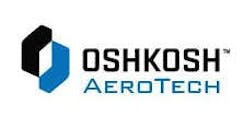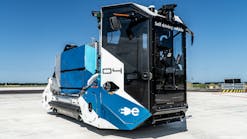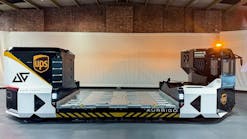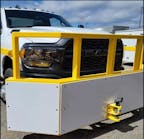With a focus on environmental benefits and possible cost savings, some ground handling operations have adopted the use of electric-powered ground support equipment.
But when stepping away from the familiarity of traditional diesel-powered GSE, making the best decision to benefit a GSE fleet can be overwhelming. For two Canadian airlines, lithium battery-powered GSE has proven to be a prudent choice.
John Moore, vice president of sales at Harlan Global Manufacturing, has worked with both WestJet and Air Canada to implement the emerging technology into their tractors in order to provide clean, durable power to GSE fleets that can operate in cold climates.
However, before harnessing the lithium battery’s potential, Harlan provided hybrid tractors that could switch between diesel and lead acid battery power.
The hybrid tractor afforded some of the benefits of an electric vehicle but was backed up by diesel fuel to ensure the equipment could make it back to charging stations, which were often located in remote areas of the airport.
“A lot of time, logistically, they don’t put these charging stations in a place where they’re convenient or logistically ideal in order to do the work the airlines need to do,” Moore explains.
“We were trying to stretch the lead acid technology with a hybrid,” he adds. “So we have an on-board generator that charges the lead acid battery out there in the middle of nowhere, and when it got back to the charger, you could plug it in as well.”
Approximately five years ago, Harlan removed the lead acid battery from tractors and replaced it with a lithium battery source.
“Making a long story short, they found out using the lithium battery, they didn’t need to charge it anymore with the hybrid generator,” Moore says. “It was doing the job all electrically.”
Able to handle the work load required without switching to diesel power, Air Canada tested a tractor purely powered by a lithium battery and found that, too, performed as needed. Changing the energy source did not detract from the work the vehicle needed to perform.
“Our electric tractor is very strong – it’s the same rear axle, same major componentry,” Moore explains.
Although Air Canada had originally planned to invest in the hybrid tractors, Moore says they saw more potential for fuel savings and green technology during the lithium tests, and ordered five tractors be converted from diesel to lithium for its location in Calgary. The airline also traded in 15 additional units to secure new lithium-powered tractors.
Likewise, WestJet is operating 29 lithium-powered units at Calgary.
Benefits and Limitations
The electric GSE solved an issue airlines are facing at Calgary International Airport, in which the use of internal combustion (IC) engines in their bag rooms will be banned. In fact, Leigh Hoey, GSE manager at WestJet, says the primary driver of pursuing alternative powered GSE was to improve air quality for its employees in bag rooms and other areas.
What’s more, lithium batteries can be charged indoors because they do not gas like lead acid models.
“If you charge a lead acid battery in a closed room, you have to have a lot of sophisticated ventilation systems, recovery of lead acid spills when it boils over – there are all kinds of things that are different to lead acid than charging lithium,” says Harlan’s Moore. “Lithium is a closed system. You simply charge it and discharge it. You don’t have to maintain that battery. You don’t have to add water.”
Removing water from the equation is critical in Canada’s often cold environment. If water freezes, a battery can be damaged.
“Without an existing electric program, we deemed it made more sense to pursue newer technology lithium over lead acid due to the ability of lithium to more reliably operate in our potentially very cold climates,” says Hoey.
“Lithium was sort of the only way they could go for total operation,” Moore adds. “They’re using these things out in blizzard conditions and -30 degree weather.”
Moore says using electric GSE can provide thousands of dollars in fuel savings annually, especially compared to diesel tractors that are often left idling on the ramp in order to combat frigid temperature conditions.
“They’ll idle all day, and that’s a lot of money,” he notes. “It’s a greener ramp, and it’s quieter out there with lithium.”
Hoey points out that the extreme cold weather Canadian stations face can have an effect on lithium powered GSE units, too, especially when left unused outdoors.
“But generally, the unit can be moved indoors to warm up and it will recover without issue,” he says.
Hoey says finding qualified technicians has been a challenge, but believes as electric vehicles become prevalent, the issue will diminish.
From a design standpoint, lithium offers added versatility. Lithium batteries can be installed at the back of the tractor where lead acid batteries are typically housed, or they can be installed under the hood on a conventional design tractor.
“A lot of safety departments like that for standard operating procedure,” Moore says. “I can convert old tractors to the lithium electric in that old frame. And I can give you a new frame that looks and feels like a diesel – but it’s not. You can’t do that with lead acid.”
Battery Charging Requirements
Properly charging the lithium batteries is critical, but that can be done quickly with the right infrastructure in place.
“If you have the charging ability, you can charge a lithium from zero,” says Moore of Harlan, adding that’s rarely the case, as Air Canada put the technology through extensive testing and rarely returned the equipment with less than a 50-percent charge.
While Moore is confident in a lithium battery’s capacity, the charging infrastructure is crucial to getting the most out of electric vehicle technology.
“You can go out and spend a lot of money on batteries. But if you don’t have the ability to charge it, or there is no power to charge, you have a problem,” he says.
In Calgary, the desire was to set up the electric fleet similar to the way electric cars are supported in public places.
“We came up with an on-board charger that works like a golf cart,” Moore says, noting it will work on a 110 or 220 circuit, and in Air Canada’s case a 208. “That didn’t necessitate a huge rebuild for infrastructure for chargers.
“So essentially, you have a charging station,” he continues. “Now, the charger is on-board the tractor. But the technology to turn it on and off is in an EV charger, compliant to SAE J1772, which is for charging electrical vehicles like cars.”
Utilizing the charging technology that’s becoming common in the automotive world has created a safe, common charging solution for workers to use at the Calgary airport.
Other airlines are already using several types of fast-chargers for lead acid batteries. Those same chargers can be programmed to service the lithium batteries that power Harlan’s electric tractors.
“Invest in fast charging solutions, either stand alone or on-board charging via EVSE,” WestJet’s Hoey says. “Be sure to understand the actual running hours required so you can size batteries appropriately.”
Additional Considerations
For electric-powered GSE fleets, including units that utilize lithium, the ease of implementation varies depending on the size of an operation.
A small station, with wall service, could have an electric tractor up and running within 90 days of making the decision to go electric, Harlan’s Moore says. However larger stations that may need significant charging infrastructure installed could take up to a year.
“It depends on what you’re doing. There’s no cookie cutter approach,” Moore says. “I think nine times out of 10, you have the electrical power to run a few baggage tractors or belt loaders there at that station already.”
Small operations, adds WestJet’s Hoey, can easily run with less capacity, especially if taking advantage of opportunity charges between flights. With smaller batteries required, initial costs can be reduced.
However, after seeing air quality for employees improve and GSE maintenance costs decrease, Hoey urges others not to be afraid of the upfront costs of implementing a lithium-powered fleet.
“The long-term reliability has been quite good and, with each new generation of batteries and products, reliability increases,” he says.
If possible to implement, Moore believes electric GSE technology is “the only way to go.”
While lithium-powered GSE requires maintenance, he says those requirements are significantly less than that of an IC machine. Moore says that’s an added bonus for airports that lack GSE maintenance infrastructure or for operations that choose to outsource equipment maintenance.
Additionally, pushes for greener technology makes lithium technology more attractive.
“It’s all about cost,” he explains, noting 25 more Harlan lithium tractors have been ordered by Saudi Ground Services. “If my engine goes for three or four times what it used to, and I can do it with electric – and simplify the design and the maintenance – you’re getting pressure from all sides to go that route.”







